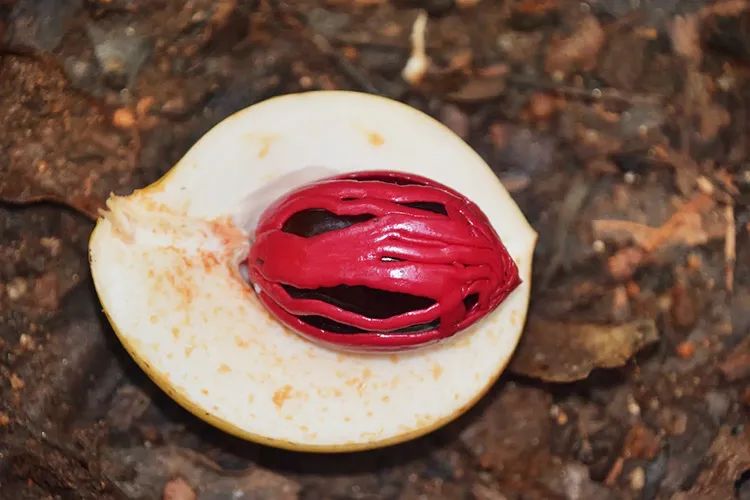2024年05月15日
荷索博士专栏 | 肉豆蔻,连结身心
作者:Dr. Malte Hozzel
肉豆蔻是原生于印度尼西亚科摩罗群岛的常绿乔木,拉丁学名为Myristica fragrans,属肉豆蔻属,是商业上的重要物种。肉豆蔻果实可产两种不同香料,果仁及红色网状层,红色网状层位于果仁和果肉之间,由皮革薄组织构成,称为“假种皮”或“肉豆蔻皮”,日晒后可形成独特的风味,再去掉果肉及果核。
肉豆蔻可长至20米高,叶片墨绿色,为雌雄异株,即白色的雄性和雌性花长在不同树上。8年后结果,15-20年左右产量达到高峰。
世界各地的烹饪美食和烘焙食品中都可看到肉豆蔻和肉豆蔻皮的身影。据说,肉豆蔻皮较肉豆蔻香气更佳,它们均对消化系统有益,也均以粉末的形式出售。
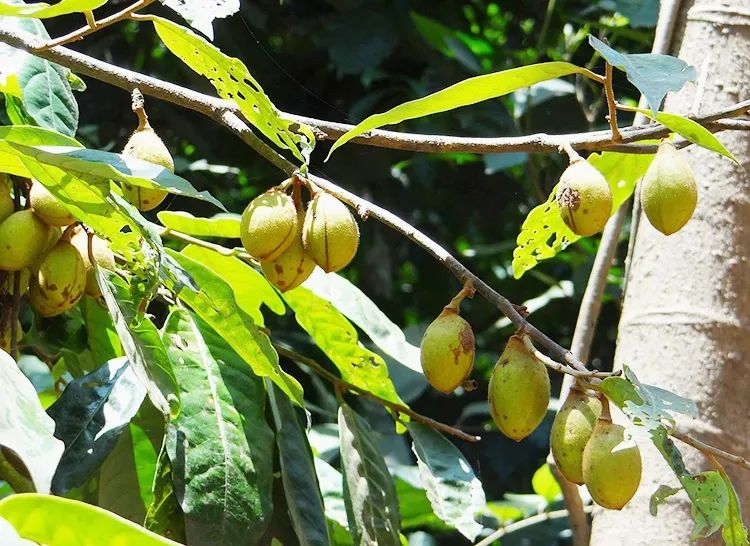
肉豆蔻精油
水蒸气蒸馏磨碎的肉豆蔻果仁可得到肉豆蔻精油,萃油率约为10%,几乎是产量最高的香料精油之一。浓郁的香气也是其在香水业和制药业广泛应用,如作为止咳糖浆或牙膏的成分,或加入饮料中。肉豆蔻精油呈淡黄色,香气浓郁,建议低剂量使用以免刺激消化系统。
在欧洲,肉豆蔻的疗愈价值似乎早被遗忘,而在亚洲,它在处理肝胆虚弱以及失眠上非常受欢迎。希尔德加德·冯·宾根赞扬了肉豆蔻镇静、强化心脏及提升专注力的特质,这也是她在处理神经系统配方中使用肉豆蔻的原因,配方中的其它成分还包括肉桂、丁香。肉豆蔻的放松特性也受到了阿育吠陀的重视,它可平衡连结消化的系统的samana vata,并可缓解头痛、发烧、口臭,对风湿性疾病和皮肤问题也有积极影响。据史料记载,拜占庭医生西蒙·赛斯曾写道,适量使用肉豆蔻,对胃、肝脏和心脏都有益处。在阿拉伯人的著作中也提到了将肉豆蔻用于消化问题及壮阳。
肉豆蔻精油的主要成分为桧烯、樟烯(50%)、蒎烯(20%),并含有不到10%的柠檬烯,沉香醇、龙脑、萜品醇、牻牛儿醇、肉豆蔻醚、黄樟素、丁香酚和异丁香酚。
肉豆蔻精油适合与橙、橡木苔、月桂、秘鲁香脂、快乐鼠尾草、迷迭香、莱姆、天竺葵、红橘、苦橙叶和芫荽精油并用。
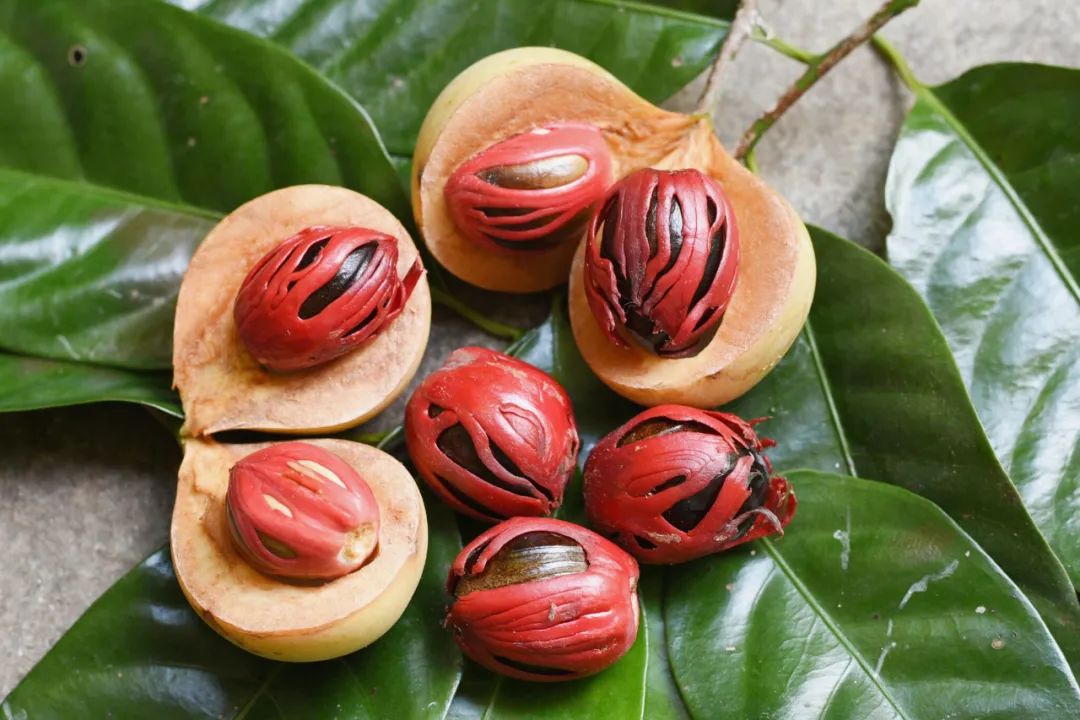
肉豆蔻的历史
从香料的历史长河看,或许肉豆蔻是由阿拉伯人通过香料之路带到的欧洲,威尼斯是第一个重要商贸中心,肉豆蔻立刻受到欢迎而且价格十分昂贵。16世纪,它被誉为“印度黄金”。英国。西班牙、葡萄牙和荷兰为了肉豆蔻贸易而展开了激烈斗争,最终,荷兰用曼哈顿岛与英国人交换东印度群岛的朗岛而获得了肉豆蔻的垄断权。在荷兰人控制肉豆蔻贸易的那段时间,他们为了维持垄断地位砍掉了其它岛屿上的树木,这对以肉豆蔻作为药物的土著民造成了巨大伤害。因具明显的抗菌特质,16世纪后半叶,肉豆蔻据说是对抗瘟疫唯一有效的药物,因此价格暴涨。在拿破仑战争时期,英国试图将肉豆蔻移植到他们的殖民地桑给巴尔和格林纳达,在格林纳达国旗上就有一颗裂开的肉豆蔻果实。如今,印度尼西亚和格林纳达是肉豆蔻的主要产地,其次是印度、马来西亚、巴布亚新几内亚、斯里兰卡和其它一些加勒比岛屿,产品主要销往欧美和日本。
在热带地区,肉豆蔻可能被昆虫或霉菌感染,部分会产生致癌物黄曲霉素。有时这些被感染的产品在其产地被非法售卖。但果实萃成精油后,就不会有致癌物的风险。通常,肉豆蔻精油的价格常比肉豆蔻便宜。
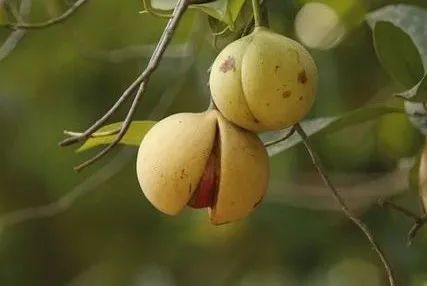
更多特质
尽管肉豆蔻属于香料,但过量使用也可能成为药物。会导致过敏、恶心等,这主要是由苯基丙烷类化合物所致。
肉豆蔻可用于预防癫痫及痉挛,效果取决于剂量。
“肉豆蔻精油对于戊四氮、最大电休克、氯化锂-匹罗卡品诱导的癫痫具抗惊厥活性,低剂量使用更有效。”
在癫痫动物模型研究中,肉豆蔻精油抗惊厥效用随着使用剂量的增加而降低。癫痫状态下,每公斤体重使用10mg肉豆蔻精油后,动物的癫痫状况得到了缓解。观察结果也支持了肉豆蔻对中枢神经系统的双相作用。
参看:https://www.ncbi.nlm.nih.gov/pmc/articles/PMC4724851/
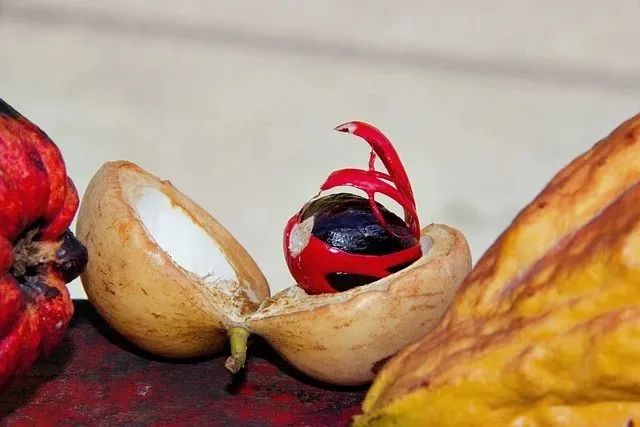
主要功效
肌肉止痛
促进消化
通经、助产
抗菌、抗寄生虫
缓解风湿
壮阳
滋养神经、镇静,改善失眠
激励肝胆
实用配方
√消化问题(Nelly Grosjean)
藏茴香 9ml
肉豆蔻 6ml
芫荽 4ml
小茴香 1ml
基础油稀释后取5滴,餐后局部涂抹在胃部和腹部。
√循环不佳-雷诺氏病 (N. Purchon)
迷迭香 20滴
黑胡椒 10滴
肉豆蔻 10滴
天竺葵 5滴
稀释到30ml甜杏仁油中,按摩手足或沐浴时使用。
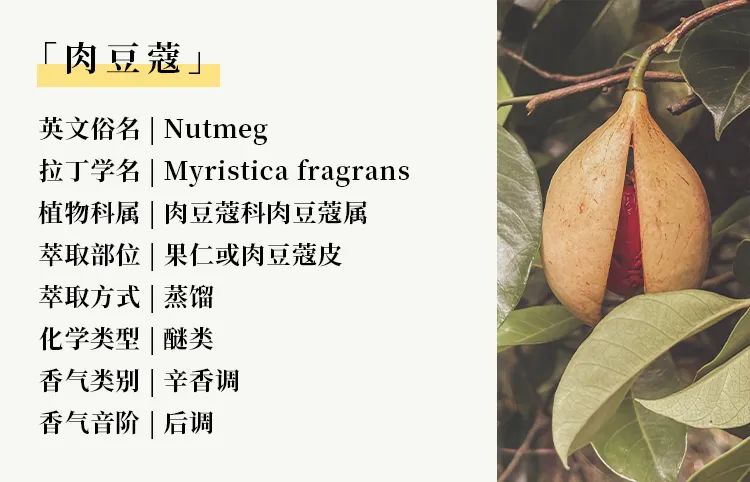
结论
总而言之,在肉豆蔻及精油中,我们发现了在成分、功效和能量层面均强大而多元的例子,它足矣引发我们对自然界中经历了历史长河考验的药用植物创造力的崇敬和好奇。
对我们而言,肉豆蔻是一种香料,但它只是一种香料么,还是能够为我们的生存、创造力及能量增加一些体验感?我们不禁自问,为什么西方文化对于与东南亚国家的胡椒、丁香、肉豆蔻等香料贸易如此着迷?在大多数西方国家缺少光照,而太阳的元素与香料类植物密不可分。正是有了香料,炽热的阳光才得以来到那里,而这也大大的改变了西方美食以及当地人的文化习俗和行为。
换个角度,肉豆蔻通过苯基丙烷类物质与宇宙天体行星相连也让我们反思。鲁道夫·斯坦纳曾说,当植物含大量醚类成分时,它就会试图与更高层次的进化序列连结,植物首先与动物联系起来。
那么人类呢?可以推断,即便是一种主要用于消化道的药物,其功效不会仅仅局限于此,直觉引领我们探寻其真正疗愈的根源所在,即微妙的心理层面。如今我们知道,肠道不只是肠道,它堪称人的第二个大脑。我们不仅要关注表象,更要看到背后的本质。
肉豆蔻这种能够带来愉悦、温暖和活力的香料,激活了我们内在的光和热,正以某种神秘的方式帮助身心重新建立连结。
(注:译文仅供学术交流,健康问题请咨询专业医师)
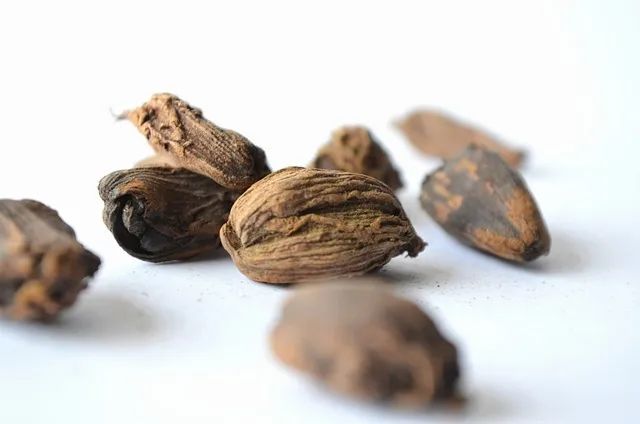
英文原文:
NUTMEG – spicy-mystic reconnector of our “body-mind”
Posted by DR. MALTE HOZZEL
The Nutmeg species of trees belongs to the Myristica genus. The botanical name of the commercially most significant species is Myristica fragrans, an evergreen tree indigenous to the Moluccas or “Spice Islands” of Indonesia. Nutmeg yields 2 different spices from the fruit, one is the actual inner kernel of the fruit and the other the red net like layer around it which consists of a leathery thin tissue called “Aril” or Mace situated between the kernel and the pulp. After sun-drying to develop its distinctive flavour, the outer fruit layer is removed and the pit or kernel separated.
The evergreen Nutmeg tree can reach a height of about 20m and has dark green leaves. It is a dioecious plant which means that its white male and female blossoms appear on separate trees. They start carrying fruits after eight years bringing the highest yields at around 15 – 20 years of age.
Both Nutmeg and Mace are used in culinary recipes worldwide for all kinds of dishes and baked goods. Mace is said to have a finer aroma than Nutmeg. Both spices are of many praised benefits for the digestive system. And both spices are usually sold as powders.
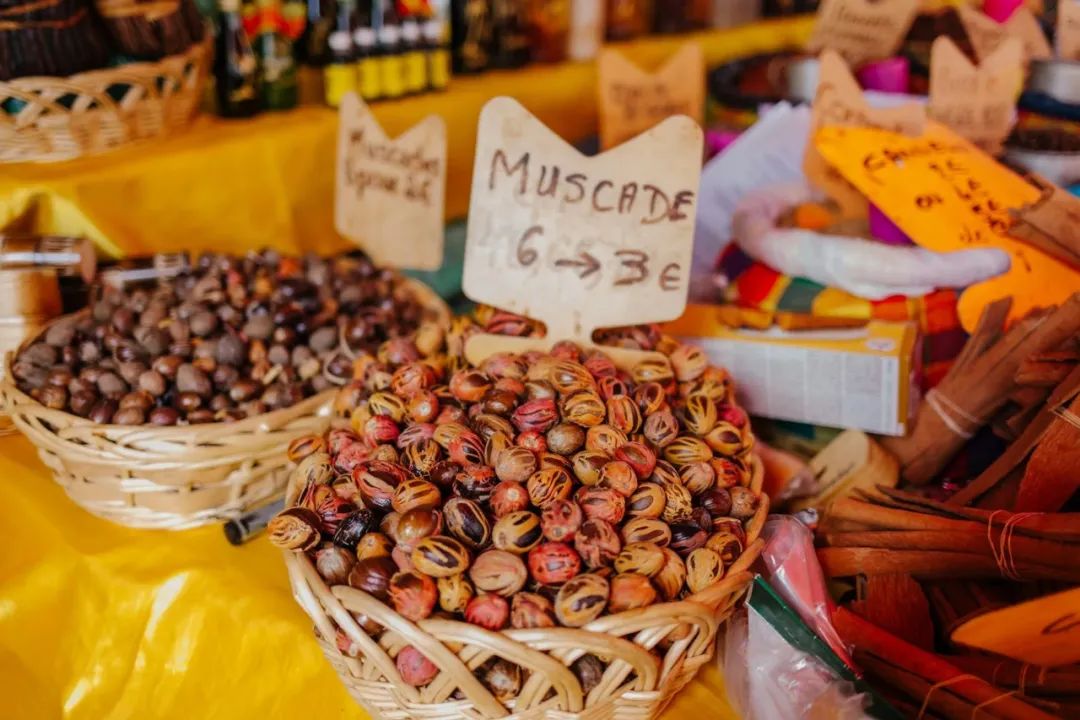
Nutmeg essential oil
The essential oil is obtained by steam distillation of the ground Nutmeg kernel. It can contain about 10% of essential oil which is probably one of the highest amounts of yield of spice essential oils. And it is highly aromatic – one of the reasons why it is in strong demand in the perfumery and pharma industry, for instance as a component in cough syrups or toothpastes. It is also used for beverages and syrups. The oil has a pale-yellow colour with smells and tastes of Nutmeg being very aromatic and intense in flavour. It is recommended to use it in small amounts only to not irritate the digestive system.
In Europe the healing properties of Nutmeg seem to have been long forgotten, whereas in Asia it is very popular as a remedy against weakness of liver and gall bladder for example, and also in case of sleeplessness. Already Hildegard von Bingen praised Nutmeg’s calming and heart strengthening effect and its increase of mental focus, a reason why she used Nutmeg in her recipe of ‘nerve cookies’ which contain also Cinnamon and Clove. Ayurvedic medicine, too, appreciates the soothing effects of Nutmeg as a spice due to its balancing effect on the Samana Vata dosha in the human body which is linked to the digestive system. Ayurveda also mentions Nutmeg as remedy to help against headaches, fever, and against bad breath. Nutmeg has also positive influences on rheumatic diseases and skin problems. According to historical reports, already the Byzantine doctor Simon Seth wrote that the fruit of Nutmeg is beneficial for the stomach, the liver and the heart if used moderately. In Arabian writings one can find Nutmeg spice mentioned for digestive problems and as an aphrodisiac too.
A chemical analysis of the oil shows the main ingredients consisting of Sabinene or Camphene (50%) and d-Pinene (20%), less than 10% are Dipentene, d-Linanool, d-Borneol, i-terpineol, Geraniol, Myristcin, Sagrole, Eugenol, iso-Eugnol.
Nutmeg oil blends well with oils of Orange, Oakmoss, Bay Laurel, Peru balsam, Clary Sage, Rosemary, Lime, Geranium, Mandarin, Petitgrain and Coriander.
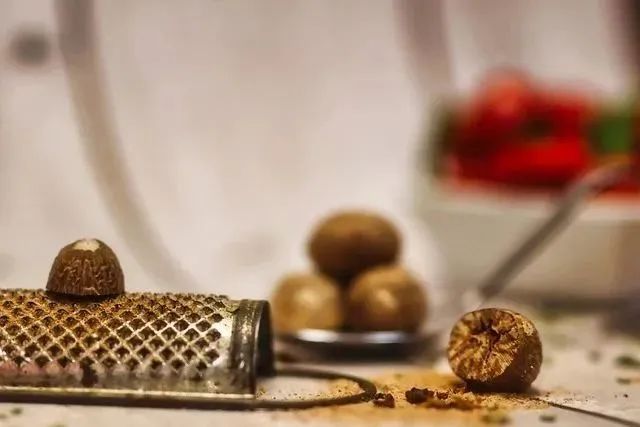
A bit on the History
Looking at the spice from the historical viewpoint, probably Nutmeg came to Europe by the Arabs via the spice trails with Venice first being the major “customer” and trader. Nutmeg became quickly very popular and expensive. In the sixteenth century it was called the ‘gold of India’. The British, Spanish, Portuguese and Dutch were fighting intensely with one another on the Nutmeg trade, and finally the Dutch received the monopoly by exchanging with the British the island of Manhattan against the small island of Run in the East-Indian Archipelago. During that time when the Dutch had the supremacy over the Nutmeg trade, they felled the trees on other islands in order to enforce their own monopoly – to the great harm of the indigenous population who were relying on Nutmeg also as medicine. During the second half of the sixteenth century Nutmeg was said to be the only effective medicine against the plague, an effect supported by the fact that it has clear antibacterial properties. Consequently, the prices increased immensely. During the Napoleonic wars the English managed to transplant some Nutmeg trees to their own colonial holdings, especially to Zanzibar and Grenada. The national flag of Grenada shows a split open Nutmeg fruit. Indonesia and Grenada today are the main producers followed by India, Malaysia, Papua New Guinea, Sri Lanka and some other Caribbean Islands. The main importers are the European Community, the United States and Japan.
In tropical areas Nutmeg can be infested by insects or mould with some of them producing the carcinogen aflatoxins. Sometimes such infected products are put on the market illegally in the producing countries. But the nuts can be distilled into the essential oil without danger for the customers. The essential oil often is less expensive than the corresponding amount of highly qualitative Nutmegs.
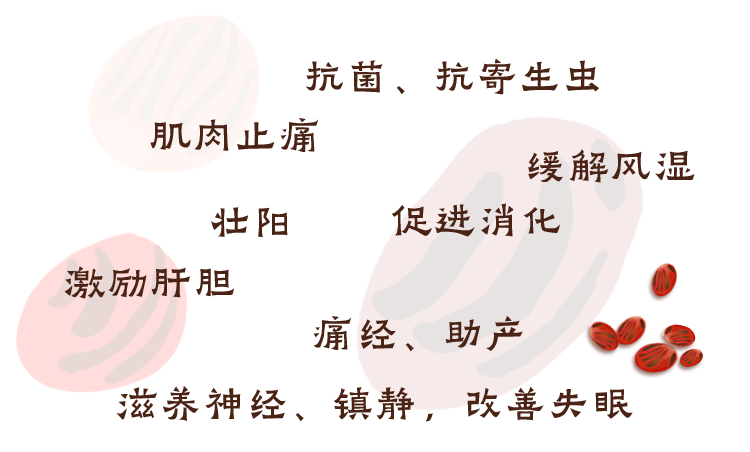
More on properties and recipes
Nutmeg, even as a spice, can be considered as a drug if taken in excess. If overdosed – can lead to hypersensitivity, nausea etc. This is mainly caused by the presence of compounds called phenyl propanoids:
Nutmeg is often mentioned to help against seizures, convulsions, and epilepsy. This effect is totally dose dependent:
“Nutmeg (Myristica fragrans, MF) possesses anticonvulsant activity against PTZ, MES and lithium-pilocarpine induced seizures and lower doses were more effective in inhibiting seizures…
In various animal models of seizures used in study, the anticonvulsant activity of MF decreased with increasing doses. In status epilepticus, the animals receiving MF in a dose of 10 mg/kg reduced the severity of seizures at much earlier time. These observations support the biphasic effect of MF (Nutmeg) on the central nervous system.
https://www.ncbi.nlm.nih.gov/pmc/articles/PMC4724851/
Main properties summarized
• analgesic and pain-relieving on the muscles
• digestive stimulant
• emmenagogue – regulates menstruation, promotes childbirth
• antiseptic and anti-parasitic
• anti-rheumatic
• aphrodisiac
• nervous toner and tranquilizer (good also for insomnia)
• good for weak liver and gall bladder
Some formulas
Digestive problems (Nelly Grosjean)
• Caraway: 9ml
• Nutmeg: 6ml
• Coriander: 4ml
• Cumin: 1ml
Dilute the mixture in a little vegetable oil and apply 5 drops of the mixture in frictions on the stomach and abdomen after a meal.
Circulatory disorder – Raynaud’s disease (N. Purchon)
• Rosemary: 20 drops
• Black pepper: 10 drops
• Nutmeg: 10 drops
• Geranium: 5 drops
in sweet Almond oil: 2 tablespoons
Use as a massage oil on the hands and feet or in a bath.
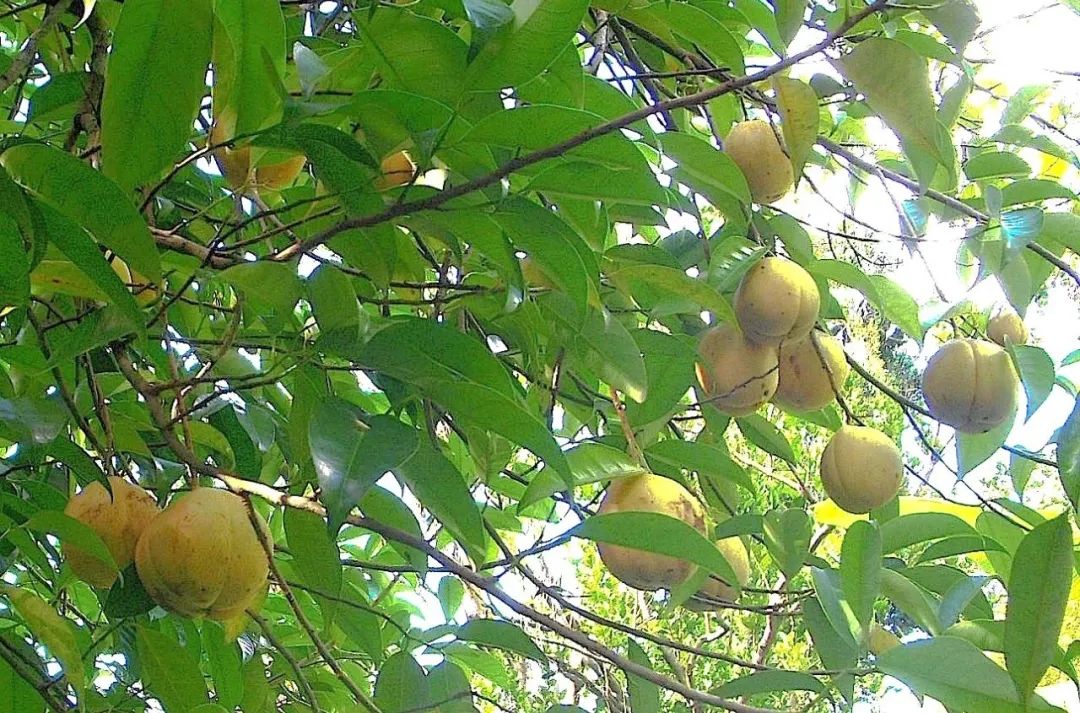
Conclusion
All in all, we can say that in Nutmeg and it essential oil we find another example of a powerful and versatile combination of compounds, effects, energies which are more than enough to trigger our admiration and curiosity for Nature’s creativity in terms of time-tested medicinal plant evolution.
Nutmeg is a spice for us, yes, but what does it mean? Is a spice just a “spice” or may it be that a spice has something to do with “spicing up” our existence, our own creativity, our own energies? We have to ask ourselves: Why was the Western culture so fascinated when the “spice trade” with the South-East Asian countries started with Pepper, Clove, Nutmeg etc.? It is true: there was the hot Sun lacking in mot of the Western countries – and the “element” of Sun has a lot to do with the spice plant group. And this hot Sun was now made available and “imported” thanks to these spices – which dramatically changed also the Wester cuisine … and maybe the cultural habits and behaviours of many people too.
Another thought: Nutmeg’s connection via the phenyl propanoids with the akashic, ethereal, or astral planes gives us something to reflect. When a plant has strong ethereal compounds, Rudolf Steiner already remarked, it tries to connect through this with a higher evolutionary order. In the case of the vegetal kingdom it tries to connect particularly first with the animal kingdom.
And in the case of us humans? We can deduce that even a medicine, mainly just used for the digestive tract, can be more than “just that”. An inner intuitive logic pulls us towards looking at that area where true healing has its roots – namely the subtle layers of our psycho-physiological build-up. Our guts are more than “just guts”, we know this today. From “guts to brain” goes the song – or does it go “from brain to guts, back and forth” ? :):) Anyhow, anyway, we have to dance to the music of the subtle and the gross, and often, what seems gross hides the subtle behind…
Nutmeg, a pleasantly warming and invigorating spice which triggers that inner fire, that inner light in us, which can help us in some mysterious ways to reconnect or straighten certain “loosened threads” within the network of our “body-mind”.
